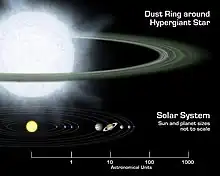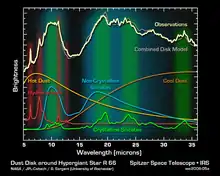| Observation data Epoch J2000 Equinox J2000 | |
|---|---|
| Constellation | Mensa |
| Right ascension | 04h 56m 47.0791s |
| Declination | −69° 50′ 24.792″ |
| Apparent magnitude (V) | 10.6[1] |
| Characteristics | |
| Spectral type | B8Iae[2] |
| U−B color index | -0.66[1] |
| B−V color index | 0.14[1] |
| Variable type | LBV?[1] |
| Astrometry | |
| Radial velocity (Rv) | 278 km/s |
| Proper motion (μ) | RA: 1.63 mas/yr Dec.: -2.38 mas/yr |
| Absolute magnitude (MV) | -8.5[1] |
| Details | |
| Mass | <30[3] M☉ |
| Radius | 131[3] R☉ |
| Luminosity | 320,000[3] L☉ |
| Temperature | 12,000[3] K |
| Other designations | |
| Database references | |
| SIMBAD | data |
HD 268835 (or R66) (30 SM) is one of two stars that were identified by NASA's Spitzer Space Telescope in the Milky Way's nearest neighbor galaxy, the Large Magellanic Cloud (the other being R 126 or HD 37974), as being circled by monstrous dust disks that are theorised to be the origin of planets.
Significance
Both HD 268835 and HD 37974 are classified as hypergiants, very large and very bright. The dust cloud around them surprised astronomers because stars as big as these were thought to be inhospitable to planet formation as they have very strong winds making it difficult/impossible for the dust clouds to "condense" into planets. "We do not know if planets like those in our solar system are able to form in the highly energetic, dynamic environment of these massive stars, but if they could, their existence would be a short and exciting one" said Charles Beichman, an astronomer at NASA's Jet Propulsion Laboratory and the California Institute of Technology, both in Pasadena, California.[4]


References
- 1 2 3 4 5 Stahl, O.; Wolf, B.; Zickgraf, F.-J.; Leitherer, C.; Bastian, U.; de Groot, M. J. H. (April 1983). "R 66(Aeq) - an LMC B supergiant with a massive cool and dusty wind". Astronomy and Astrophysics. 120 (2): 287–296. Bibcode:1983A&A...120..287S.
- ↑ Kastner, J. H.; Thorndike, S. L.; Romanczyk, P. A.; Buchanan, C. L.; Hrivnak, B. J.; Sahai, R.; Egan, M. (2008). "The Large Magellanic Cloud's Top 250: Classification of the Most Luminous Compact 8 μm Sources in the Large Magellanic Cloud". The Astronomical Journal. 136 (3): 1221–1241. arXiv:astro-ph/0703584. Bibcode:2008AJ....136.1221K. doi:10.1088/0004-6256/136/3/1221. S2CID 117820349.
- 1 2 3 4 Kastner, J. H.; Buchanan, C. L.; Sargent, B.; Forrest, W. J. (2006). "SpitzerSpectroscopy of Dusty Disks around B[e] Hypergiants in the Large Magellanic Cloud". The Astrophysical Journal. 638 (1): L29–L32. Bibcode:2006ApJ...638L..29K. doi:10.1086/500804.
- ↑ NASA's Spitzer Uncovers Hints of Mega Solar Systems, Nasa.gov, accessed 11 Feb 2006